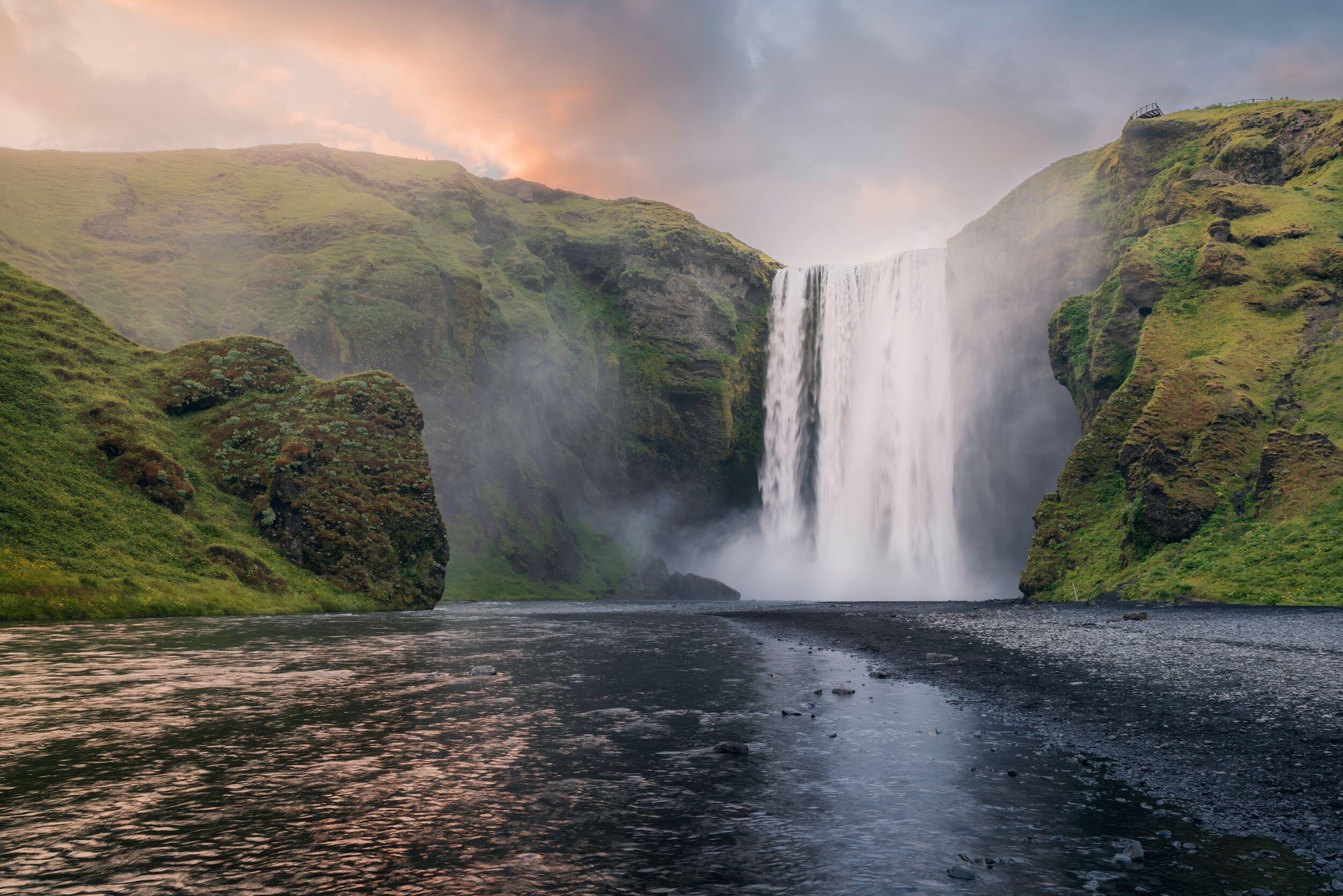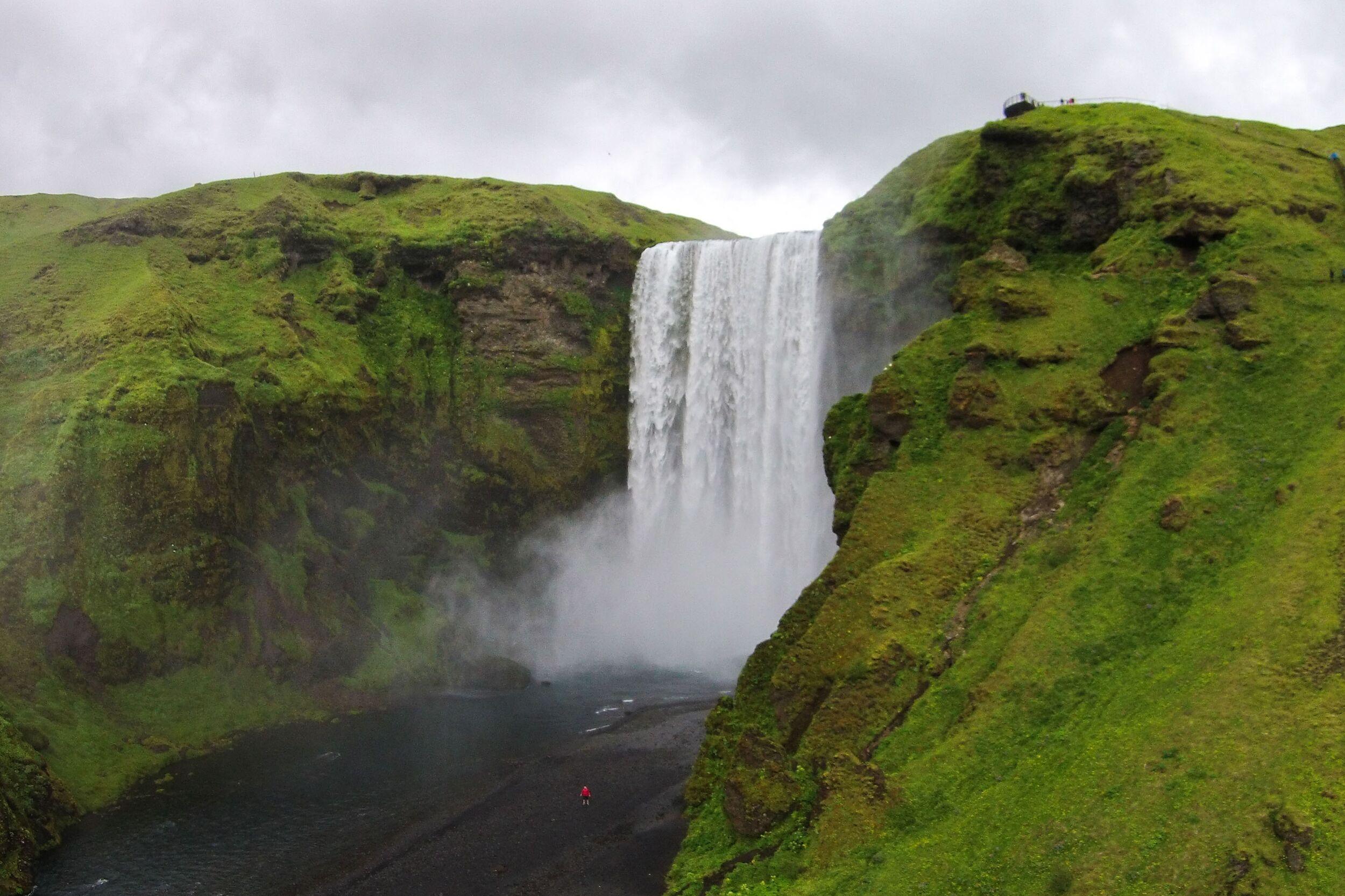
Everything to know about Skógar before you visit
The history of Skógar
Skógar is a tiny village on the south coast of Iceland. It has a permanent population of about 25 people, although its accommodation and eating options may make it seem a little bigger.
Since its settlement, Skógar has been a farming village, and the international visitors aside, it still remains that way. In fact, you can see some of the most traditional buildings in the whole of Iceland in Skógar—a testament to its important place in Icelandic culture.
The village was established about a thousand years ago when the Vikings first arrived in Iceland. It’s mentioned in the book known as Landnámabók, Iceland’s “Book of Settlements”, the record of the earliest days of Icelandic culture. A Viking known as Þrasi Þórólfsson first settled in Skógar, right next to the waterfall known as Skógafoss.
One of the most famous stories about Þrasi is that he buried a chest full of gold and treasure behind the waters of Skógafoss. Once upon a time, you could still see the chest—or so the story goes—and in the seventeenth century someone tried to grasp it. However, the ring on the side of the chest snapped off. That ring can now be seen in the Skógar Museum.
Since then, Skógar has been home to farmers who have cultivated the land in the area. At the Skógar Museum, you can see the sorts of homes they would have once lived in. These are stone huts with turf covering their roofs. It’s a fascinating insight into how rural Icelanders would once have lived.
If you look at a map, you’ll notice that Skógar sits just below the famous volcano of Eyjafjallajökull. As a result, it’s always been vulnerable to that volcano’s power. For example, in 2010, the area was flooded by glacier melt, while the air became thick with dust. Luckily, no one was hurt.
Today, Skógar is one of the best places in Iceland to discover the country’s history and see its most impressive natural sights. It’s the perfect base from which to explore the south coast.
What to do in and around Skógar
At the heart of Iceland’s south coast, there’s plenty to do in and around Skógar.
One of the most unique attractions in the village is the Skógar Museum. Set up in 1949, it’s among the oldest museums in Iceland—and it’s a fascinating insight into the country’s history and culture. Visit if you want to see how real Icelanders would have lived throughout the centuries.
For example, here you can see the iconic turf-roof houses, modest dwellings with grass growing on the roof. You can also dive into Iceland’s history of fishing and agriculture, to understand the challenges that Icelanders would have had to overcome to survive in this harsh landscape.
If you want to see some of Iceland’s most spectacular natural sights, you’re in the right place too. A short distance from the village of Skógar is Skógafoss, perhaps the most astonishing of all of Iceland’s waterfalls. Water thunders over a cliff into a stunning crater, creating rainbows in the mist.
Get your hiking boots on and walk to the viewing platform above the waterfall. You can continue up to other waterfalls too, including Steinbogafoss and Fellsfoss.
This path along the Skógá river passes many more waterfalls on its way to Fimmvörðuháls, the “five cairn pass”. This full-day hike takes you to the area between the glaciers, Eyjafjallajökull and Mýrdalsjökull, where you can see the impacts of the 2010 Eyjafjallajökull eruption. It’s an incredible walk through some of Iceland’s most beautiful scenery. It can even take you on to Þórsmörk, the hiking hub in the Icelandic highlands.
A short distance down route 1 from Skógar you’ll find Sólheimasandur. This is a stark black-sand plain that’s now most famous for the plane wreck that has sat on its sand for the last fifty years. It’s an eerie, atmospheric, and completely unforgettable place.
Or visit Sólheimajökull, one of the outlet glaciers of the mighty Mýrdalsjökull. If you want to explore the icy landscapes that give this country its name, this could be the place to do it.
You can also stretch out for the half-hour drive to Vík. It’s a charming fishing village with a famed beach, the mysterious Reynisfjara.
How to get there
Skógar is located on route 1, the famous “Ring Road” that draws a loop around Iceland. That means it’s really easy to get to, whether you’re coming from Reykjavík or from the east.
If you’re driving from Reykjavík, the journey will take you about 2 hours. You’ll cover 156 kilometres (97 miles) from the capital, through some of the most scenic countryside in Iceland. Alternatively, Skógar is about a half-hour drive from Vík, or about 33 kilometres (20.5 miles).
However, you may not want to drive—and that’s okay too. Instead, why not take a guided tour of the south coast? This way, you’ll see the very best of Iceland, without having to worry about navigating or managing the potentially tricky road conditions.
For example, we can pick you up from Reykjavík and show you the likes of Skógafoss, Sólheimajökull, and Vík. You’ll also benefit from a local guide, who will share local knowledge that you won’t find in a guide book.
Alternatively, just jump on the highland bus from Reykjavík. Throughout the summer, the bus leaves Reykjavík’s BSÍ station at 07:00 every day and arrives in Skógar at 09:45.
Frequently asked questions
There should be no hard “g” sound when you pronounce Skógar. Instead, in Icelandic, it almost rhymes with the English word “slower”.
If you’re visiting Iceland, don’t worry too much about the local pronunciation. Icelanders will understand you even if you get it a little wrong.
Skógar is a small village on the south coast of Iceland. It lies on route 1, the Ring Road, immediately south of Eyjafjallajökull and the valley and hiking hub at Þórsmörk.
The village is 156 kilometres (97 miles) east of the capital city of Reykjavík. If you’re driving, the journey should take about 2 hours.
Skógar simply means “forests”. Once upon a time, the whole area would have been covered in trees.
TV shows, films, and music videos have been shot at Skógafoss. These are some of the most famous:
- Thor: The Dark World. Featuring Chris Hemsworth, parts of this film were shot at Skógafoss and in the highlands.
- Vikings. The Irish-Canadian TV show featured Skógafoss in its fifth season.
- Eurovision Song Contest: The Story of Fire Saga included scenes at Skógafoss.
- Justin Bieber’s music video for “I’ll Show You” featured the waterfall.
Skógar is a very small village, with a population of about 25. With a number of hotels and campsites, this number swells a little in the summer.
Most people allow about 45 minutes to walk from the Skógafoss car park up the steps to the top of the waterfall. Once you’re there, you can spend as much time as you like! It’s an awesome place and a great opportunity for gorgeous photos.
Skógar is a really convenient base that you can use to explore the length of the south coast. So, while you can cover the sights in the vicinity of the village in a day, you may want to stay longer to see the incredible attractions in the surrounding area.
For example, it can be a great place from which to visit the glaciers of Eyjafjallajökull and Mýrdalsjökull, to see the waterfalls of the south coast, and to even visit Heimaey in the Westman Islands.
It’s completely free to visit Skógafoss if you’re visiting alone. There is no entrance fee and you will not be charged to use the car park.
As a natural sight, Skógafoss is open 24 hours a day. If you’re staying in the area during the summer, visiting at night can be a great idea. There’ll be fewer people around and you’ll get to see the waterfall beneath the gorgeous light of the midnight sun.
We don’t recommend that you visit the waterfall in the dark though. It’s a bit of a walk and it may not be safe if you cannot see.
According to the old Icelandic saga, Landnámabók (“The Book of Settlements”), Skógar was settled by a Viking sorcerer named Þrasi Þórólfsson.
He and a local neighbour argued over the land. Part of their fight concerned the location of a flooded river. Neither man wanted it on his land, so each diverted its course onto their rival’s territory. Only after much back and forth did they agree on the course of the river, and that became the Jökulsá river.
Þrasi is also thought to have buried treasure beneath the Skógafoss waterfall. Somewhere behind the rainbows and the tumbling water, the treasure is said to still be there.
Folklore aside, Skógar’s thousand-year history has been simply one of farming. At the Skógar Museum, you can see the traditional turf-roofed houses that Icelanders here lived in from the period of settlement up until the 20th century.
Skógar is a beautiful village at the heart of one of Iceland’s most attractive areas. With its ample choice of hotels and places to eat, it’s truly a great place to stay on the south coast.
Skógafoss is known as one of the most beautiful waterfalls in all of Iceland. It’s an enormous thundering torrent surrounded by high cliffs. Simply, it’s famous because it’s so wonderful.
You may also have heard the legend of the treasure hidden behind the water. It was put there by the Viking, Þrasi, who once lived in the area.
Skógafoss is an incredible sight, and you’ll want to do it justice with an awesome photo. Here are some ways you can snap a shot you’re proud of:
- Get a friend to stand in your photo. It’s not just for the memory of being with them, but because it will show Skógafoss’s true scale.
- Wait for the northern lights. The aurora borealis can make your Skógafoss photo even more special.
- Find a unique perspective. A great photo doesn’t need to be taken from the same angle as everyone else’s. Find a unique spot for a memorable shot.
- Invest in the right gear. Unfortunately, a cheap smartphone is unlikely to produce a quality photo. Bring a camera with a good zoom and a wide-angle lens.
Related tours

Highland Bus - Reykjavík to Skógar
In the summer, Skógar comes alive, turning into a lush green wonderland under the towering Eyjafjöll mountains. The area is home to one of Iceland’s most famous waterfalls, Skógafoss, a pearl of the south coast. The drive to Skógar is a scenic ride through the picturesque south of Iceland, passing by small farms and charming villages with astounding views of the surrounding mountains and volcanoes on clear days. Whether you are planning a day trip to the region or a multi-day hike, leave the driving to us!

